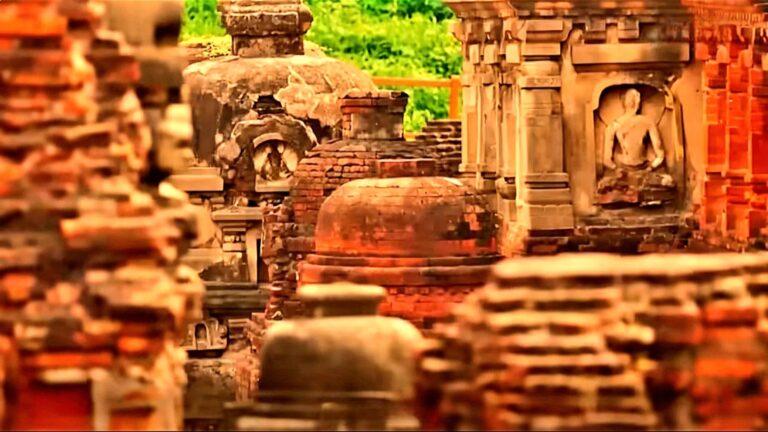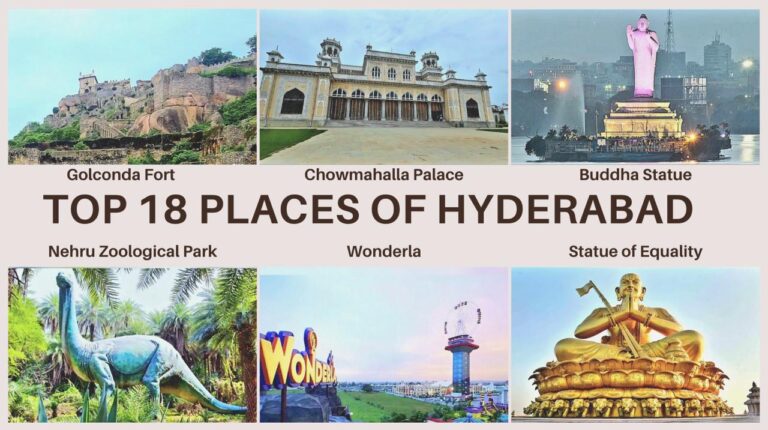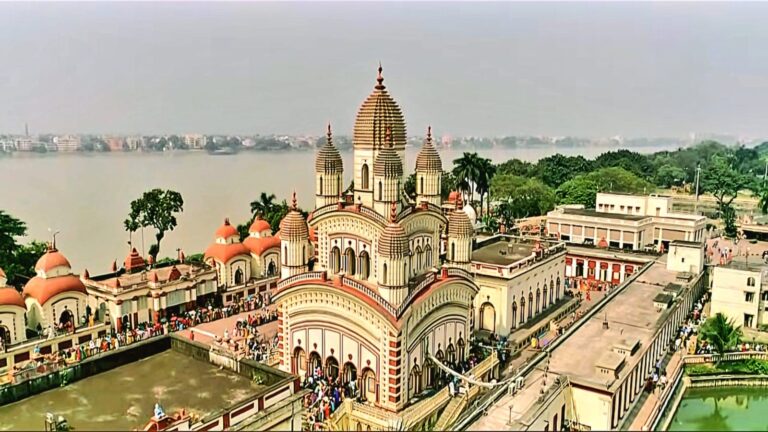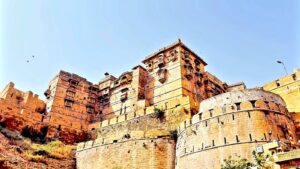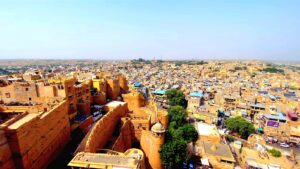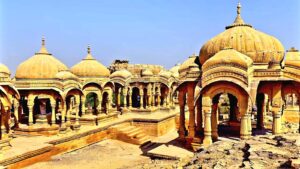Ambaji: A Sacred Pilgrimage Site in Gujarat
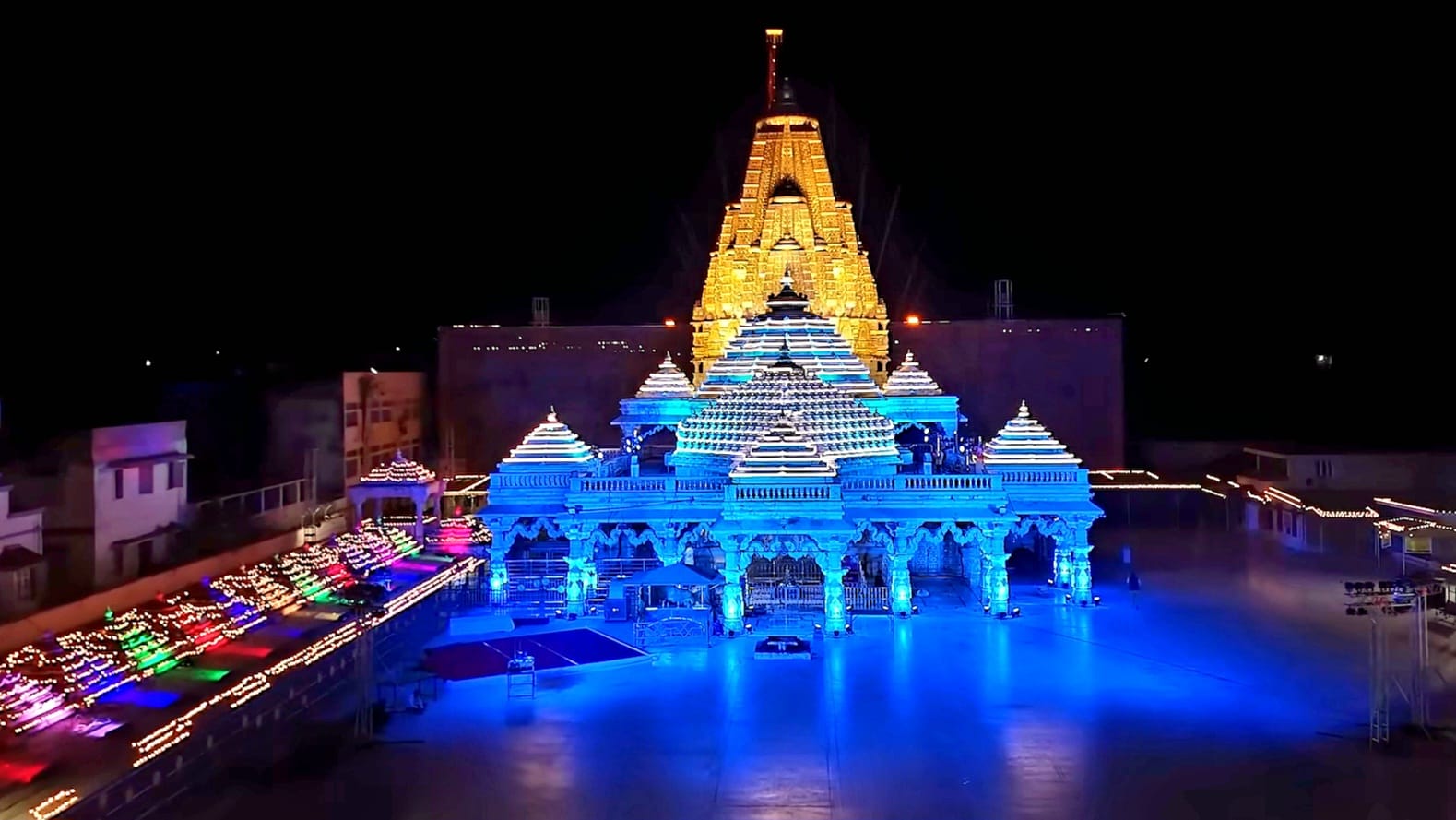
Ambaji is a renowned pilgrimage destination in Gujarat, revered for its spiritual significance. The Ambaji Temple, also known as Akshara Suri Amba, is located in the Arasur Hills, near the source of the Saraswati River, on the southwestern end of the Aravalli mountain range. This temple is one of the 51 Shakti Peethas, making it one of the most important Shakti Peeths in India.
The original seat of Ambaji Mata resides atop Gabbar Hill, a short distance from the temple in the town. Devotees can either trek or take a ropeway to the summit of Gabbar Hill to offer their prayers. The temple draws a large number of devotees throughout the year, especially on the full moon day of every month, with the Bhadrapada Purnima in September being the most prominent. A grand fair is organized during this time, attracting pilgrims from all over the country who come to worship Maa Ambe.
The temple’s serene and divine atmosphere, along with the scenic beauty of the Aravalli Hills, makes it a place of peace and devotion. For devotees and tourists alike, visiting Ambaji offers both spiritual enrichment and an opportunity to experience the vibrant cultural traditions of Gujarat.
How to Reach Ambaji Temple

Ambaji Temple, located in the Arasur Hills of Gujarat, is easily accessible through various modes of transportation. Here’s how you can reach this revered pilgrimage site:
1. By Train
The nearest railway station to Ambaji is Abu Road Station, which is just 20 km away. Another nearby station is Palanpur Junction, located about 65 km from Ambaji. Both stations are well-connected to major cities across Gujarat and other parts of India. From these stations, frequent bus services and private taxis are available to take you to Ambaji.
2. By Air
If you prefer to travel by air, the nearest international airport is Sardar Vallabhbhai Patel International Airport in Ahmedabad, located approximately 179 km from Ambaji. Another option is Maharana Pratap Airport in Udaipur, which is around 187 km away. From both airports, private taxis and bus services are available to Ambaji, providing a convenient journey to the temple.
3. By Road
Ambaji is well-connected by road, with direct access from major cities and towns. The nearest major city is Palanpur, from where regular buses run to Ambaji. The town is close to National Highways, making it easy to reach from various parts of Gujarat and neighboring states. Private and state-run buses, as well as taxis, frequently ply to and from Ambaji, offering travelers multiple options for a smooth road trip.
Best Time to Visit Ambaji
The ideal time to visit Ambaji is between October and March, when the weather is pleasant and favorable for sightseeing and religious activities. This period also coincides with the Navratri festival, which is a grand celebration at the temple, attracting thousands of devotees. During this time, the temple is beautifully decorated, and vibrant cultural and religious events take place, making it an unforgettable experience for visitors.
For those coming during peak seasons like Navratri, there are special arrangements for visitors, including dedicated resting areas to ensure a comfortable stay.
Stay Options in Ambaji

When visiting Ambaji, you have a variety of accommodation options, ranging from dharamshalas to private hotels. Some popular choices include Parvati Pranam Dharamshala, Ambaji Shakti Pathikashram, Nandani Ashram, Sita Bhavan Sadan, and Shri Ganesh Bhavan.
For more budget-friendly options, Shri Arasuri Mata Devasthan Trust provides well-maintained rooms. AC double-bed rooms are available starting from ₹587, while non-AC rooms start at ₹295. The trust also operates a restaurant offering affordable and hygienic meals. Additionally, numerous private hotels, dharamshalas, guesthouses, and public facilities such as restaurants, parking, and restrooms are available around the temple.
For convenience, online booking for accommodations is available through the temple’s official website.
Tip: If you plan to visit during Navratri, it’s essential to book your stay in advance, as all accommodations fill up quickly during this busy festival season.
Places to Visit in Ambaji
1.Ambaji Temple

Located near Khoj Yar Chowk, Ambaji Mata Mandir is one of the most revered Shakti Peethas in India. Situated in the Arasur Hills near the source of the Saraswati River, this temple, dating back to the pre-Vedic period, is unique because it has no idol. Instead, the focal point of worship is the Vishwa Yantra, a triangular sacred symbol with mystical inscriptions representing the deity, Arasuri Ambe Maa. Ambaji Temple is not only a spiritual center but also a significant landmark for pilgrims throughout India.
2.Gabbar Hill

About 4 km from Ambaji village, Gabbar Hill is considered the original seat of Ambaji Mata. There are around 999 stone steps leading to the temple atop the hill, which houses a continuously lit lamp that can be seen from the main Ambaji Temple at night. Devotees often climb the hill to pay homage to the footprints of the goddess beneath a peepal tree. Visitors can also option for the ropeway, which offers scenic views, including a sunset point and nearby caves.
3.Kamakshi Temple

Located 1 km from Ambaji on the Brahma Highway, the Kamakshi Temple is a significant religious site where replicas of all 51 Shakti Peethas have been established. This temple complex educates devotees about the Shakti sect and the incarnations of Adi Shakti Mata, making it an essential stop for those exploring the spiritual heritage of the region.
4.Mangal Wan

Mangal Wan is a unique botanical garden located atop Kailash Tekri, 1.5 km from the main Ambaji Temple. This garden is not only a scenic spot but also popular for its zodiac-based plants. Many visitors take home plants based on their sun signs, adding a personalized and spiritual touch to their visit.
5.Mansarovar
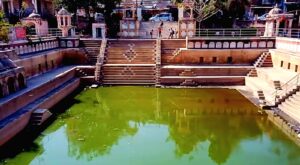
Located behind the Ambaji Temple, Mansarovar is a large rectangular pond that dates back to the late 16th century. Built by Shri Tapishanker, a devotee of Ambaji Mata, this pond is flanked by two temples—one dedicated to Mahadev and the other to Ajay Devi. Devotees often take a holy dip in this pond, making it a significant site for both religious and historical purposes.
6.Kailash Tekri

Kailash Tekri, located around 1 to 1.5 km from Ambaji Temple, offers breathtaking sunset views and houses a Shaivite temple with intricate stone architecture. The Shivalaya here adds to the spiritual atmosphere, making it a peaceful retreat for worshippers and tourists alike.
7.Koteshwar Mahadev

Just 8 km from Ambaji, near the source of the Saraswati River, lies the ancient temple of Shri Koteshwar Mahadev. This temple is linked to the legendary sage Valmiki and features a carved cow’s mouth from which the Saraswati River is said to flow. It is an important pilgrimage site for devotees of Lord Shiva.
8.Kumbharia Jain Temple

Located 1.5 km from Ambaji, the Kumbharia Jain Temple complex is dedicated to Shri Neminath Bhagwan. These temples are renowned for their exquisite Chaulukyan architecture, featuring intricate carvings and elaborate designs. Along with other famous Jain temples such as Dilwara and Girnar, the Kumbharia temples are considered some of the finest Jain heritage sites in India.
Local Dishes and Cuisine in Ambaji:

1.Gujarati Thali:
A must-try when in Ambaji, the traditional Gujarati thali includes a variety of items such as roti (flatbread), dal (lentils), shaak (vegetable curry), rice, khichdi, farsan (savory snack), pickles, and sweets like jalebi or shrikhand. The flavors are a delightful blend of sweet, spicy, and tangy, served together in a wholesome meal.
2.Farsan:
Farsan is a typical Gujarati snack served as part of a meal. Some of the popular farsan items you can try in Ambaji include dhokla, khandvi, fafda, and patra. These light and flavorful snacks are perfect for a quick bite in between your temple visits.
3.Poha:
A popular breakfast dish across Gujarat, poha is a light and flavorful dish made from flattened rice, cooked with spices, peanuts, and garnished with fresh coriander and a squeeze of lemon. It is filling yet easy on the stomach, making it an ideal meal to start your day.
4.Khichu:
A simple yet comforting dish made from rice flour, khichu is seasoned with spices and steamed, often enjoyed with a drizzle of sesame oil and some chili powder.
5.Sabudana Khichdi:
Sabudana khichdi is a popular dish during fasting, made with soaked tapioca pearls, roasted peanuts, and a blend of spices. It’s light, nutritious, and flavorful.
6.Thepla and Chutney:
Thepla is a flatbread made from wheat flour, fenugreek leaves (methi), and spices. It’s typically eaten with chutneys or yogurt and makes for a great meal or snack while traveling in and around Ambaji.
Sweets and Desserts:

1.Mohanthal:
A famous Gujarati sweet, mohanthal is a dense fudge-like dessert made from gram flour, ghee, and sugar, flavored with cardamom and garnished with nuts. It’s rich and delicious, perfect as a treat during your visit.
2.Shrikhand:
Shrikhand is a sweetened yogurt dessert flavored with cardamom or saffron and garnished with almonds and pistachios. It’s a refreshing dessert, often served as part of a Gujarati thali.
3.Ghooghra:
Ghooghra is a sweet dumpling filled with a mixture of semolina, sugar, and nuts, deep-fried to perfection. This is a popular festive sweet in Gujarat.
4.Jalebi and Fafda:
If you visit Ambaji during breakfast hours, don’t miss out on the classic combination of jalebi (crispy, syrupy sweet) with fafda (crispy chickpea flour snack). This combination is a local favorite and widely available.
Where to Eat in Ambaji
•Shri Arasuri Mata Devasthan Trust Bhojanalaya:
If you want a simple and affordable meal, the Shri Arasuri Mata Trust Bhojanalaya offers pure vegetarian food in a clean and peaceful environment. The food is prepared and served by the temple trust and is a popular choice for devotees.
•Local Dhabas and Restaurants:
Ambaji has plenty of dhabas and restaurants around the temple area where you can enjoy local delicacies and simple vegetarian meals. Some of these offer North Indian dishes, Gujarati snacks, and thalis at reasonable prices.
•Street Food:
The streets around the temple are filled with vendors selling chaat, pani puri, samosas, and other snacks. These are great for a quick, tasty, and affordable bite.





